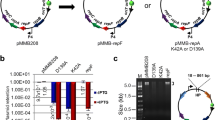Abstract
In order to study virulence factors of the opportunistic oral pathogen Streptococcus mutans we have used Tn917 mutagenesis to generate mutants defective in specific phenotypic properties believed to be associated with virulence. This work describes the procedures required to use the temperature-sensitive transposon Tn917 delivery vector pTV1-OK, along with two techniques to recover inactivated genes. This vector has proven useful in generating transposon mutants of a poorly transformable S. mutans strain. We have successfully isolated mutants with diminished growth at pH 5.0, with defects in production of a mutacin, formerly known as BLIS or bacteriocin-like inhibitory substance and with nutritional requirements in minimal media including adenine, glutamate and arginine auxotrophy. The transposon has been used successfully in two strains of S. mutans, JH1005 and NG8, where transposition frequencies of 10−5 and 10−4 were observed, respectively. Rescue of inactivated genes was achieved using a recovery vector, pTV21Δ2TetM, that generates a replicative E. coli plasmid by reciprocal recombination with the mutant S. mutans chromosomal transposon site, and shot-gun cloning chromosomal DNA of mutants into pUC18, followed by selection of ampicillin and erythromycin resistant transformants in E. coli. The techniques described here can be adapted for generating mutants and recovering genes from a number of other Gram-positive and possibly Gram-negative bacteria.
Similar content being viewed by others
References
Ausebel FM, Brent R, Kingston RE, Moore DD, Seidman JG, Smith JA, Struhl K (eds) (1985–1997). Current protocols in molecular biology. John Wiley and Sons.
Babb BL, Collett HJ, Reid SJ, Woods DR (1993). Transposon mutagenesis of Clostridium acetobutylicum P262: Isolation and characterization of solvent deficient and metronidazole resistant mutants. FEMS Microbiol Lett 114: 343–348.
Burne RA, Quivey RG Jr (1994). Use of transposons to dissect pathogenic strategies of Gram-positive bacteria. Methods Enzymol 235: 405–426.
Camilli A, Portnoy DA, Youngman P (1990). Insertional mutagenesis of Listeria monocytogenes with a novel Tn917 derivative that allows direct cloning of DNA flanking transposon insertions. J Bacteriol 172: 3738–3744.
Carlsson J (1970). Nutritional requirements of Streptococcus mutans. Caries Res 4: 305–320.
Cheung AL, Koomey JM, Butler CA, Projan SJ, Fischetti VA (1992). Regulation of exoprotein expression in Staphylococcus aureus by a locus (sar) distinct from agr. Proc Natl Acad Sci (USA) 89: 6462–6466.
Clewell DB, Tomich PK, Gawron-Burke MC, Franke AE, Yagi Y, An FY (1982). Mapping of Streptococcus faecalis plasmids pAD1 and pAD2 and studies relating to transposition of Tn917. J Bacteriol 152: 1220–1230.
Cossart P, Vicente MF, Mengaud J, Baquero F, Perez-Diaz JC, and Berche P (1989). Listeriosin O is essential for virulence of Listeria monocytogenes: Direct evidence obtained gene complementation. Infect Immun 57: 3629–3236.
Crowley PJ, Gutierrez JA, Hillman JD, Bleiweis AS (1997). Genetic and physiologic analysis of a formyltetrahydrofolate synthetase mutant of Streptococcus mutans. J Bacteriol 179: 1563–1572.
Cvitkovitch DG, Gutierrez JA, Bleiweis AS (1997). Role of the citrate pathway in glutamate biosynthesis by Streptococcus mutans. J Bacteriol 179: 650–655.
Framson PE, Nizet V, Nittayajarn A, Youngman P, Rubens CE (1995). Mutagenesis of Streptococcus agalactiae (Group B Streptococcus) with Tn917, abstr. H-152. In: Abstracts of the 95th General Meeting of the American Society for Microbiology, American Society for Microbiology, Washington, DC.
Hillman JD, Johnson KP, Yaphe BI (1984). Isolation of a Streptococcus mutans strain producing a novel bacteriocin. Infect Immun 44: 141–144.
Gutierrez JA, Crowley PJ, Brown DP, Hillman JD, Youngman P, Bleiweis AS (1996). Insertional mutagenesis and recovery of interrupted genes of Streptococcus mutans by using transposon Tn917: Preliminary characterization of mutants displaying acid sensitivity and nutritional requirements. J Bacteriol 178: 4166–4175.
Kok J, Van der Vossen JMBN, Venema G (1984). Construction of plasmid cloning vectors for lactic streptococci which also replicate in Bacillus subtilis and Escherichia coli. Appl Environ Microbiol 48: 726–731.
Li Z, Gutierrez JA, Bleiweis AS, Boyle MDP (1997). Tn917 mediated transposon mutagenesis of streptococcus pyogenes. Abstract B-48 in: Abstracts of the 97th General Meeting of the American Society for Microbiology. Washington: ASM Press.
Loesche WJ (1986). Role of Streptococcus mutans in human dental decay. Microbiol Rev 50: 353–380.
Maguin E, Duwat P, Hege T, Ehrlich D, Gruss A (1992). New thermosensitive plasmid for Grampositive bacteria. J Bacteriol 174: 5633–5638.
Sato Y, Yamamoto Y, Kizaki H (1997). Cloning and sequence analysis of the gene encoding a novel glucan-binding protein of Streptococcus mutans. Infect Immun 65: 668–675.
Spatafora G, Rohner K, Barnard D, Michalek S (1995). A Streptococcus mutans mutant that synthesizes elevated levels of intracellular polysaccharide is hypercariogenic in vivo. Infect Immun 63: 2556–2563.
Svensater G, Larsson U-B, Greif ECG, Cvitkovitch DG, Hamilton IR (1997). Acid tolerance response and survival by oral bacteria. Oral Microbiol and Immunol (in press).
Thomas WD, Archer GL (1989). Identification and cloning of the conjugative transfer region of Staphylococcus aureus plasmid pGO1. J Bacteriol 171: 684–691.
Tomich PK, An FY, Clewell DB (1978). A transposon (Tn917) in Streptococcus faecalis which exhibits enhanced transposition during induction of drug resistance. Cold Spring Harbor Symp Quant Biol 43: 1217–1221.
Yamada T, Igarashi K, Mitsutomi M (1980). Evaluation of cariogenicity and glycosylsucrose by a new method of measuring pH under human dental plaque in situ. J Dent Res 59: 2157–2162.
Yamashita Y, Takehara T, Kuramitsu HK (1993). Molecular characterization of a Streptococcus mutans mutant altered in environmental stress responses. J Bacteriol 175: 6220–6228.
Author information
Authors and Affiliations
Rights and permissions
About this article
Cite this article
Cvitkovitch, D.G., Gutierrez, J.A., Crowley, P.J. et al. Tn917 transposon mutagenesis and marker rescue of interrupted genes of Streptococcus mutans. Methods Cell Sci 20, 1–12 (1998). https://doi.org/10.1023/A:1009711609646
Issue Date:
DOI: https://doi.org/10.1023/A:1009711609646




